Hol Dir den wöchentlichen SPARTANAT-Newsletter.
Dein Bonus: das gratis E-Book von SPARTANAT.
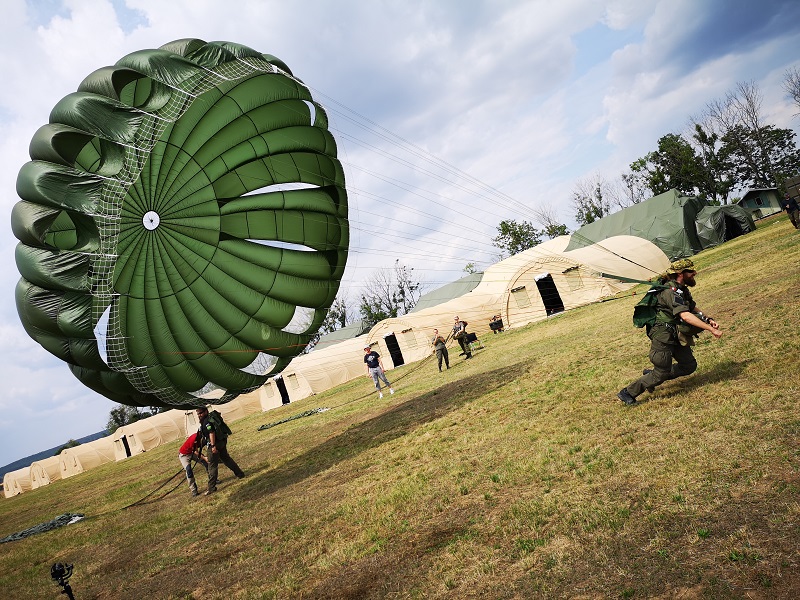
Fallschirmspringen lernen mit der MFTS
Der Traum, selbst einmal den Sprung aus einem komplett funktionstüchtigen Flugzeug zu wagen, ist für viele von uns wohl unendlich weit entfernt. Aber das tschechische Znaim ist näher als ihr denkt.
Der Traum, selbst einmal den Sprung aus einem komplett funktionstüchtigen Flugzeug zu wagen, ist für viele von uns wohl unendlich weit entfernt. Aber das tschechische Znaim ist näher als ihr denkt. In der Nähe dieses idyllischen Städtchens in Mähren hat die Militärfallschirmspringer Truppenschule (MFTS) ihre Zelte aufgeschlagen. Und das meinen wir wörtlich.
Vor dem Kurs
Wer aus einem Flugzeug fallen will, der sollte körperlich gesund sein. Das gilt es bei einem Arzt abzuchecken, denn es wird für die Teilnahme am Kurs ein ärztliches Attest benötigt. Wer keines hat, darf nicht springen. Den Vordruck für das Attest und einiges mehr an Zettelwerk erhaltet ihr nach der Anmeldung zum Kurs per Email. Auch eine empfohlene Packliste findet sich darunter, die ruhigen Gewissens befolgt werden kann.
Tag 1 – Ankommen im MFTS Camp
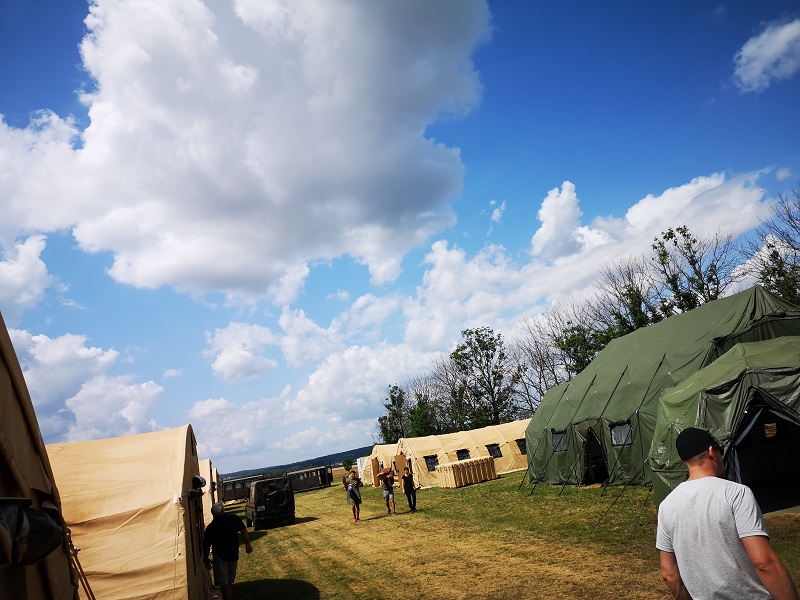 Die grüne und beige Zeltstadt gibt einem das richtige Grundgefühl, dass man bei einer Militärschule erwarten würde. Nach einer kurzen Runde über das gesamte Gelände geht es auch gleich in medias res.
Die grüne und beige Zeltstadt gibt einem das richtige Grundgefühl, dass man bei einer Militärschule erwarten würde. Nach einer kurzen Runde über das gesamte Gelände geht es auch gleich in medias res.
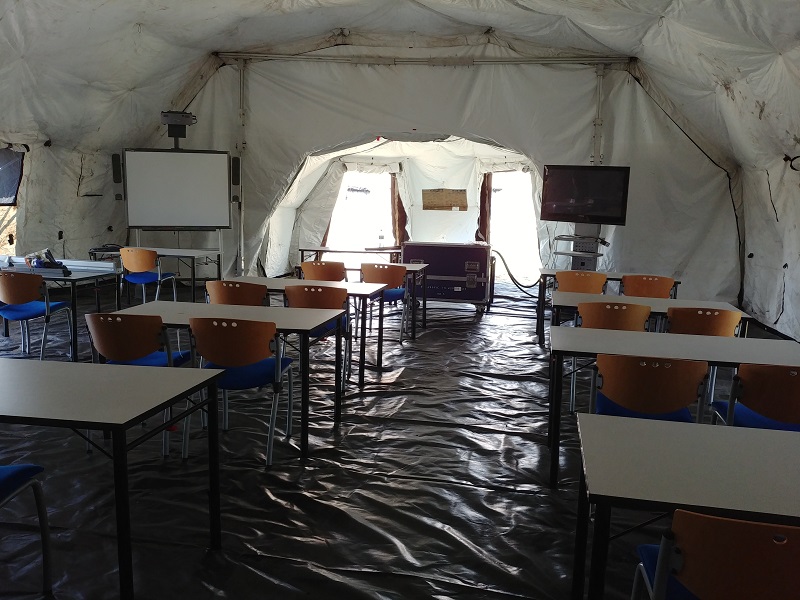 Das bedeutet, hier im Lehrsaal zuerst einmal eine kurze Einschulung wie ein echter Fallschirmsprung abläuft, auf was zu achten ist und so weiter.
Das bedeutet, hier im Lehrsaal zuerst einmal eine kurze Einschulung wie ein echter Fallschirmsprung abläuft, auf was zu achten ist und so weiter.
 Danach startet gleich die theoretische Praxis des Fallschirmpackens. Ein sehr wichtiger Schritt, denn wenn hier gepfuscht wird, öffnet sich der Schirm nicht korrekt und der Springer hat nur 3 bis 4 Sekunden Zeit zu reagieren und 10 Sekunden bis zum Boden.
Danach startet gleich die theoretische Praxis des Fallschirmpackens. Ein sehr wichtiger Schritt, denn wenn hier gepfuscht wird, öffnet sich der Schirm nicht korrekt und der Springer hat nur 3 bis 4 Sekunden Zeit zu reagieren und 10 Sekunden bis zum Boden.
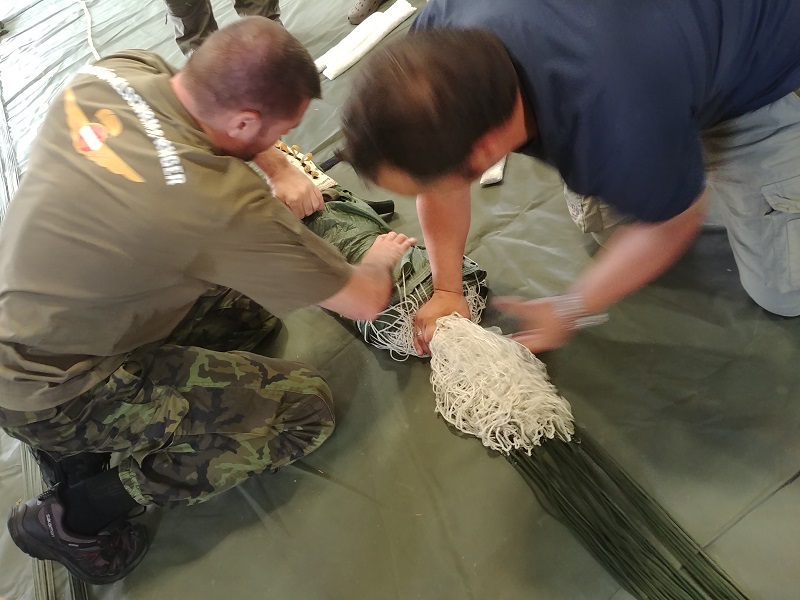 Also üben, üben, üben. Zum Glück gibt es bei der MFTS geschulte Fallschimpacker, die eine wirklich hervorragende Arbeit geleistet haben. Ihr braucht keine Angst haben, dass ihr mit eurem selbst gepackten Schirm springen müsst, außer ihr wollt es.
Also üben, üben, üben. Zum Glück gibt es bei der MFTS geschulte Fallschimpacker, die eine wirklich hervorragende Arbeit geleistet haben. Ihr braucht keine Angst haben, dass ihr mit eurem selbst gepackten Schirm springen müsst, außer ihr wollt es.
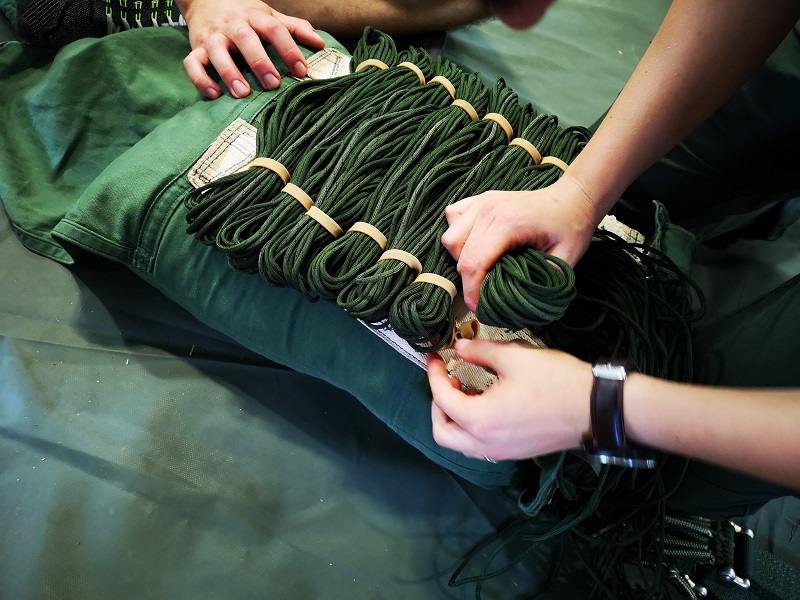 Paracord und Riggerbands in ihrem natürlichem Habitat. Für die Meisten von uns ein wirklich sehr seltener Anblick. Die Fallschirmleinen liegen geordnet auf, die bekannten und vielseitig verwendbaren Gummibänder halten die Leinen in Form.
Paracord und Riggerbands in ihrem natürlichem Habitat. Für die Meisten von uns ein wirklich sehr seltener Anblick. Die Fallschirmleinen liegen geordnet auf, die bekannten und vielseitig verwendbaren Gummibänder halten die Leinen in Form.
 Apropos in Form: Essen hält bekanntlich Leib und Seele zusammen. Nach diesem ausgiebigen Abendessen geht es ab ins Feldbett und ins Reich der Träume.
Apropos in Form: Essen hält bekanntlich Leib und Seele zusammen. Nach diesem ausgiebigen Abendessen geht es ab ins Feldbett und ins Reich der Träume.
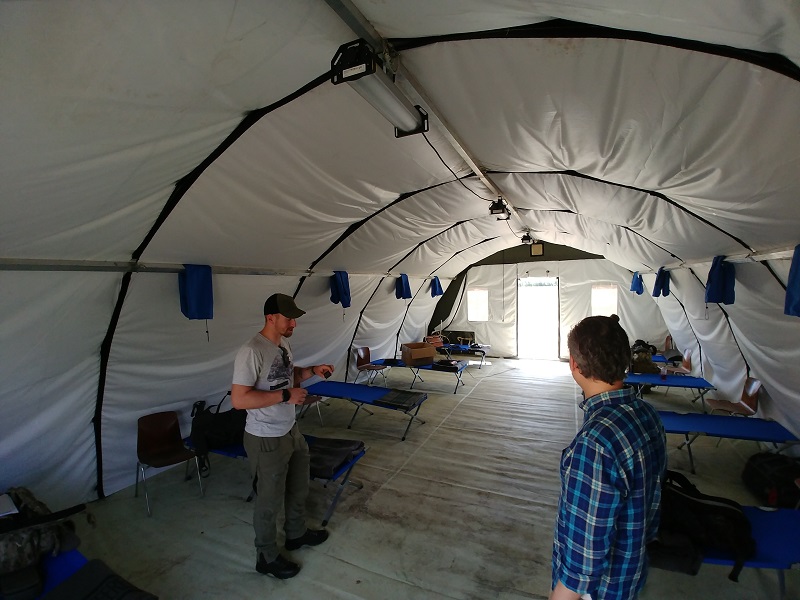 Die Schlafzelte nehmen bis zu 10 Personen auf. Besser immer Ohrstopel dabei haben, denn die Schnarcher sind unter uns. Mit Gehörschutz kann man sich auch beim Schlafen besser fallen lassen …
Die Schlafzelte nehmen bis zu 10 Personen auf. Besser immer Ohrstopel dabei haben, denn die Schnarcher sind unter uns. Mit Gehörschutz kann man sich auch beim Schlafen besser fallen lassen …
Tag 2 – Lernen ist das halbe Leben
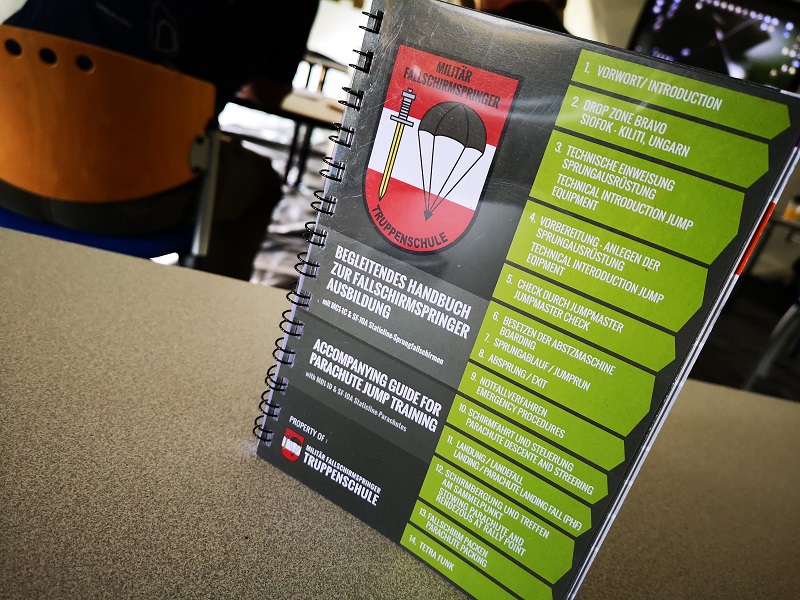 Zeitig in der Früh geht es wieder los mit Theorie, denn am Nachmittag von Tag 3 ist das erste Mal Springen angesetzt. Also besser die Köpfe füllen mit dem Wissen über Steuerung des Fallschirms.
Zeitig in der Früh geht es wieder los mit Theorie, denn am Nachmittag von Tag 3 ist das erste Mal Springen angesetzt. Also besser die Köpfe füllen mit dem Wissen über Steuerung des Fallschirms.
 Auch das Verhalten, wenn mal was schief geht, wird ausgiebigst besprochen. Sei es Landungen auf oder in Hindernissen oder der Schirm öffnet sich nicht. Zum Glück ist immer ein Reserveschirm mit dabei.
Auch das Verhalten, wenn mal was schief geht, wird ausgiebigst besprochen. Sei es Landungen auf oder in Hindernissen oder der Schirm öffnet sich nicht. Zum Glück ist immer ein Reserveschirm mit dabei.
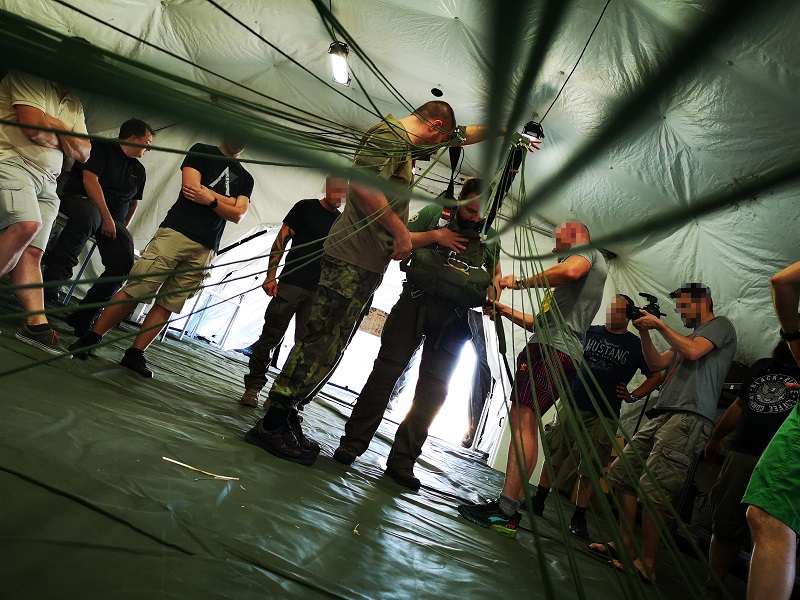 Dann wird natürlich geübt wie das ganze Gerödel korrekt angelegt wird. Auch keine intuitive Tätigkeit.
Dann wird natürlich geübt wie das ganze Gerödel korrekt angelegt wird. Auch keine intuitive Tätigkeit.
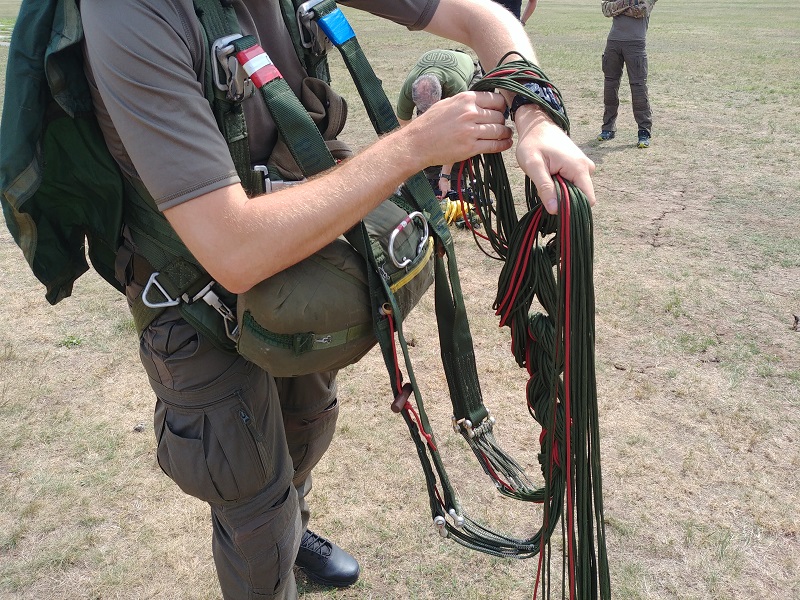 Der Sprung ist nur die halbe Arbeit. Am Boden angekommen will natürlich das richtige Einsammeln des Schirms gelernt und geübt werden.
Der Sprung ist nur die halbe Arbeit. Am Boden angekommen will natürlich das richtige Einsammeln des Schirms gelernt und geübt werden.
 Auch was tun, wenn der Wind stark weht und euch mit dem Schirm über den Boden schleift.Ihr seid auf jeden Fall nicht der erste Fallschirmspringer, dem das passiert, versprochen …
Auch was tun, wenn der Wind stark weht und euch mit dem Schirm über den Boden schleift.Ihr seid auf jeden Fall nicht der erste Fallschirmspringer, dem das passiert, versprochen …
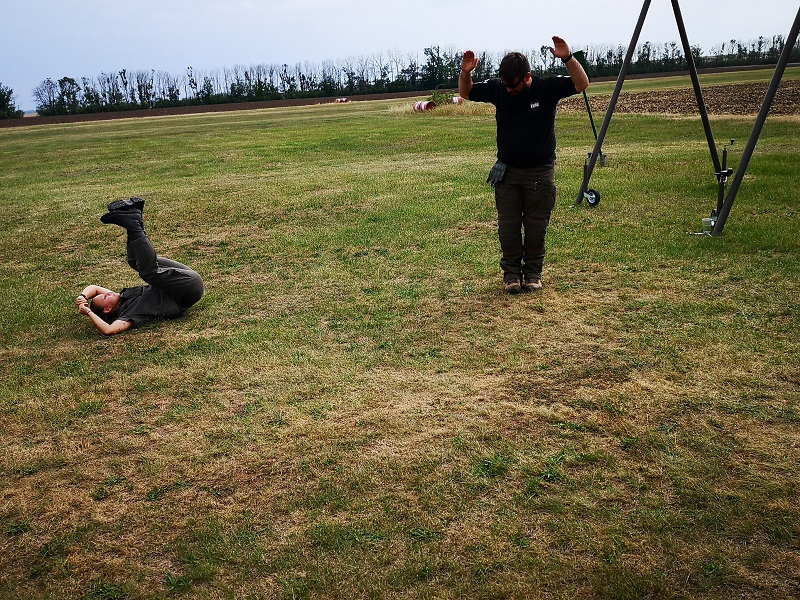 Am frühen Nachmittag geht es mit einer der wichtigsten Übungen los, dem Parachute Landing Fall (PLF). Also das gewollte Hinfallen bei der Landung.
Am frühen Nachmittag geht es mit einer der wichtigsten Übungen los, dem Parachute Landing Fall (PLF). Also das gewollte Hinfallen bei der Landung.
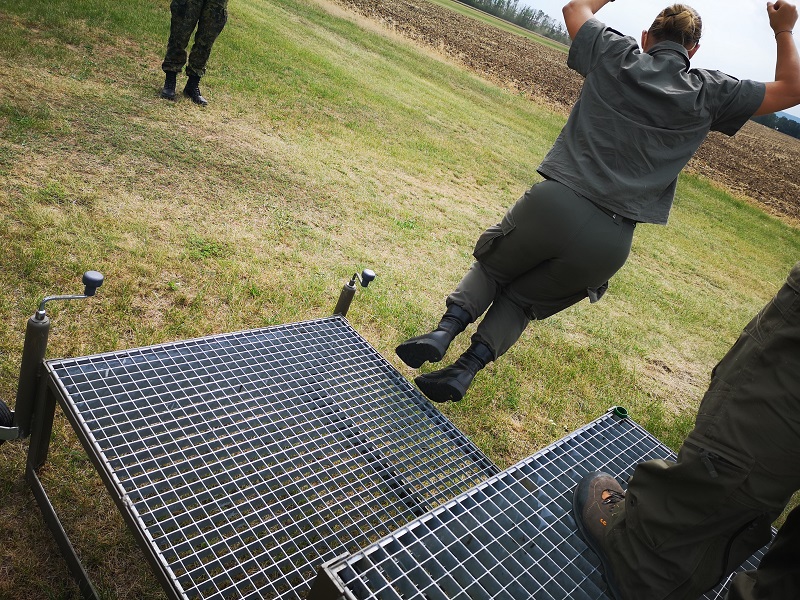 Immerhin kommt ihr mit 5 m/s am Boden auf, was 18 km/h entspricht. Ungefähr so, wie wenn ihr von einem Tisch mit Ausrüstung hinunterspringt. Zum ersten Mal formuliert sich im Gehirn die Frage: „Was genau mache ich hier?“
Immerhin kommt ihr mit 5 m/s am Boden auf, was 18 km/h entspricht. Ungefähr so, wie wenn ihr von einem Tisch mit Ausrüstung hinunterspringt. Zum ersten Mal formuliert sich im Gehirn die Frage: „Was genau mache ich hier?“
 Nach gut eineinhalb Stunden des Fallens und blauen Flecken an der Hüfte, von den nicht so gekonnten Versuchen, macht sich ein gewisses Gefühl der Sicherheit breit: Wir schaffen das!
Nach gut eineinhalb Stunden des Fallens und blauen Flecken an der Hüfte, von den nicht so gekonnten Versuchen, macht sich ein gewisses Gefühl der Sicherheit breit: Wir schaffen das!
 Nach weiterer Theorie und einem vorzüglichen Abendmahl, es könnte ja das letzte gewesen sein, geht es wieder in Bett.
Nach weiterer Theorie und einem vorzüglichen Abendmahl, es könnte ja das letzte gewesen sein, geht es wieder in Bett.
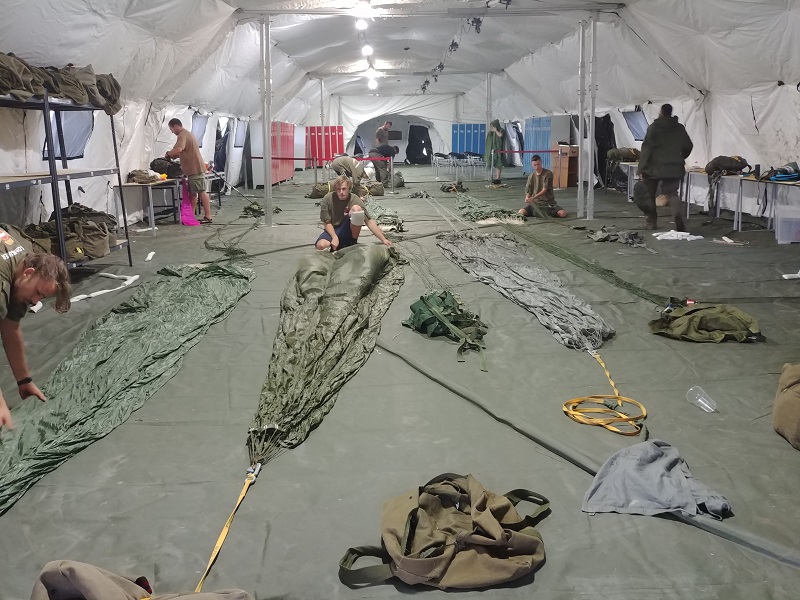 Unterdessen arbeiten in der Packhalle die Packer unermüdlich vor sich hin. So ein Schirm verstaut sich ja bekanntlich nicht von selbst. Wer es ganu wissen will, für das ordnungsgemäße Packen des Schirms benötigt ein geübter Packer 30 bis 40 Minuten.
Unterdessen arbeiten in der Packhalle die Packer unermüdlich vor sich hin. So ein Schirm verstaut sich ja bekanntlich nicht von selbst. Wer es ganu wissen will, für das ordnungsgemäße Packen des Schirms benötigt ein geübter Packer 30 bis 40 Minuten.
Tag 3 – Bereit für alles
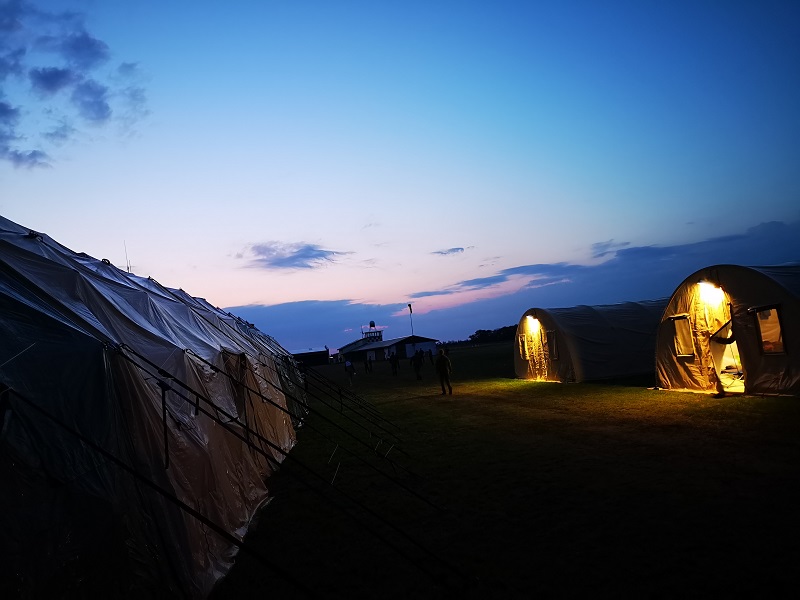 Der Tag der Enscheidung, denn am Nachmittag sind die ersten Sprünge geplant. Um den Körper schön geschmeidg zu machen, starten wir mit klassischem Morgensport um 0600 in diesen schönen Tag.
Der Tag der Enscheidung, denn am Nachmittag sind die ersten Sprünge geplant. Um den Körper schön geschmeidg zu machen, starten wir mit klassischem Morgensport um 0600 in diesen schönen Tag.
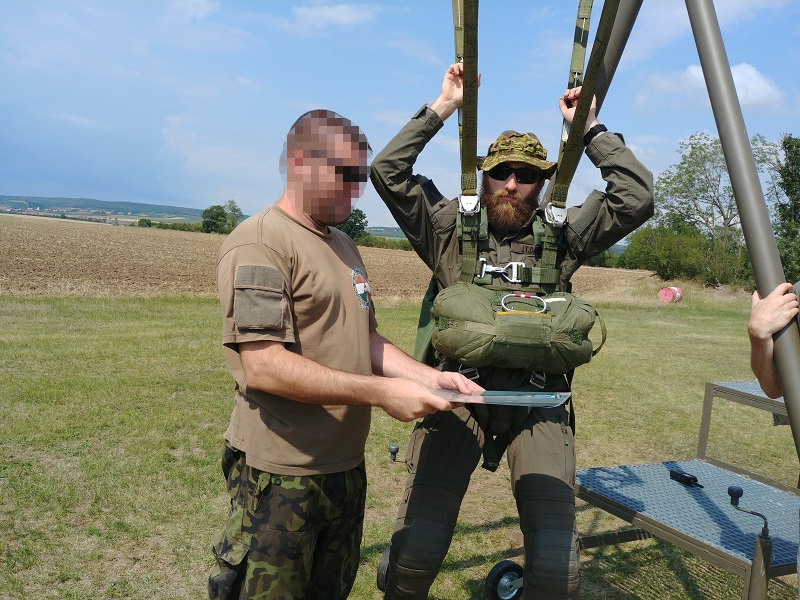 Nach dem Frühstück, gehts wieder weiter mit dem Üben. Diesmal abhängen am Hängesimulator um das Steuern zu verinnerlichen. Das will gelernt sein, damit keiner zu weit von der eigentlichen Landezone abdriftet. Auch das Verhalten im Flugzeug wird durchbesprochen und geübt.
Nach dem Frühstück, gehts wieder weiter mit dem Üben. Diesmal abhängen am Hängesimulator um das Steuern zu verinnerlichen. Das will gelernt sein, damit keiner zu weit von der eigentlichen Landezone abdriftet. Auch das Verhalten im Flugzeug wird durchbesprochen und geübt.
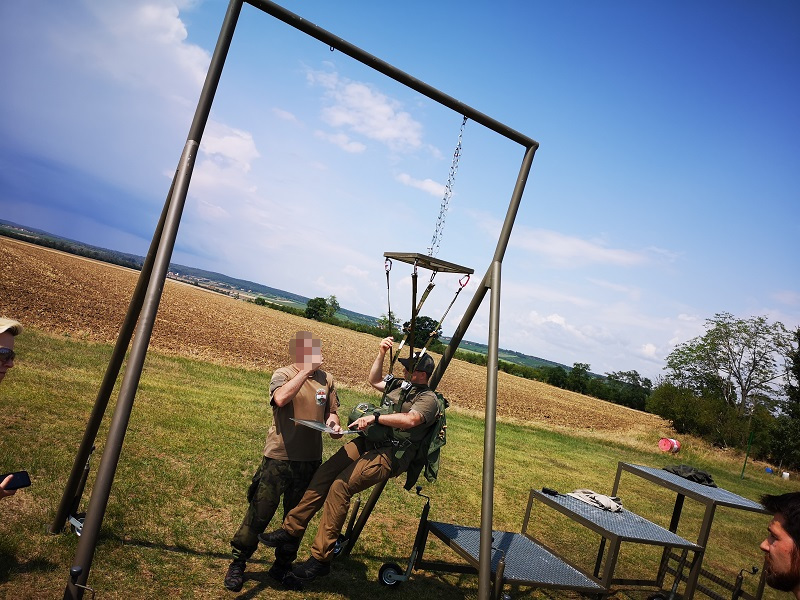 Nach dem Mittagessen wird noch etwas der PLF geübt, aber am Horizont zeigen sich massive Gewitterwolken. Die Anspannung steigt, aber das Wetter macht leider einen Strich durch die Rechnung.
Nach dem Mittagessen wird noch etwas der PLF geübt, aber am Horizont zeigen sich massive Gewitterwolken. Die Anspannung steigt, aber das Wetter macht leider einen Strich durch die Rechnung.
 Heute kein Springen. Dafür mehrere Gewitter, die über das Camp hinwegziehen. Somit genug Zeit sich nochmal intensiv mit der Theorie zu beschäftigen und den Packern bei ihrer Arbeit zu sehen.
Heute kein Springen. Dafür mehrere Gewitter, die über das Camp hinwegziehen. Somit genug Zeit sich nochmal intensiv mit der Theorie zu beschäftigen und den Packern bei ihrer Arbeit zu sehen.
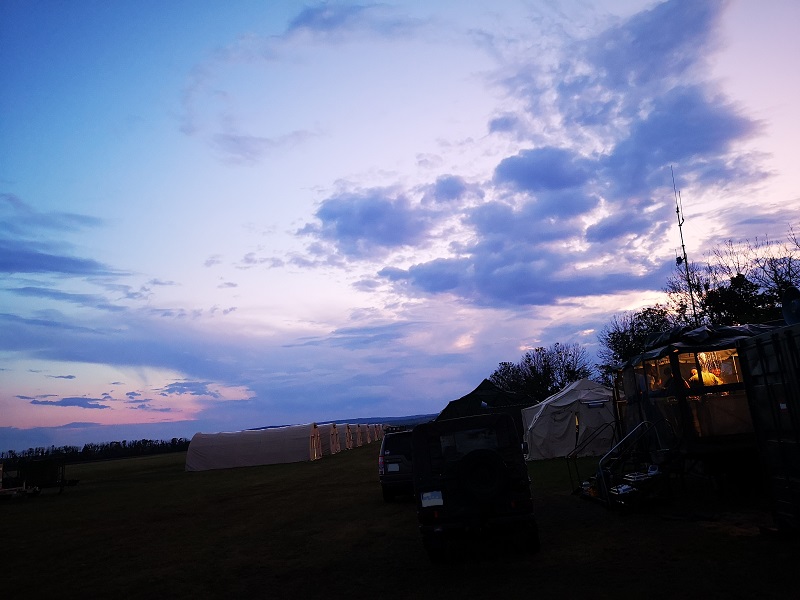 Gegen 2030 Uhr hört der teils sintflutartige Regen auf und wir werden mit einem romantischen Abendrot belohnt. Mit großer Nervosität geht es ab ins Bett. Für den nächsten Tag sind die Sprünge für 0600 geplant, also sehr zeitig Aufstehen.
Gegen 2030 Uhr hört der teils sintflutartige Regen auf und wir werden mit einem romantischen Abendrot belohnt. Mit großer Nervosität geht es ab ins Bett. Für den nächsten Tag sind die Sprünge für 0600 geplant, also sehr zeitig Aufstehen.
Tag 4 – Wir springen
 Morgenstund hat Gold im Mund. Das können wir so nicht bestätigen, aber schön ist es schon irgendwie. Aufstehen um 0430 und Sport um 0500. Danach schnelle Körperpflege und dann wird es ernst. Sehr ernst.
Morgenstund hat Gold im Mund. Das können wir so nicht bestätigen, aber schön ist es schon irgendwie. Aufstehen um 0430 und Sport um 0500. Danach schnelle Körperpflege und dann wird es ernst. Sehr ernst.
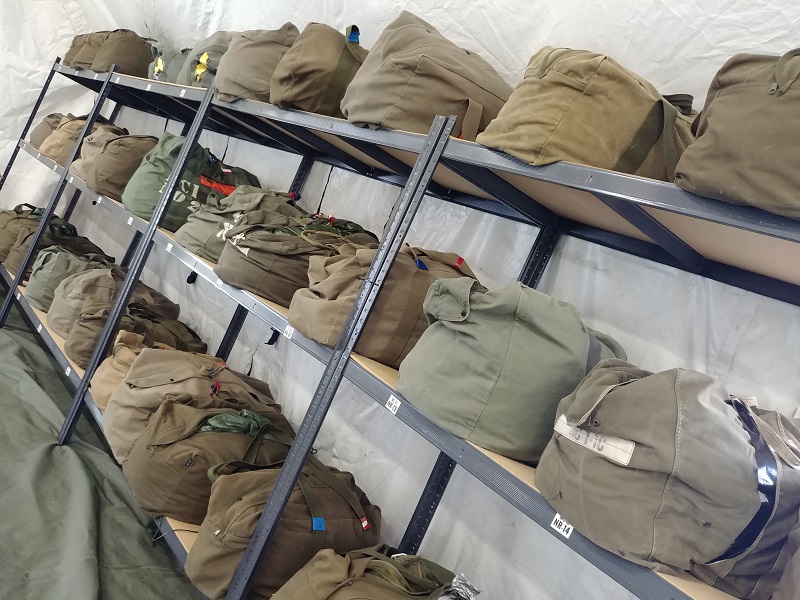 Ab in die Packhalle und die Fallschirme Anlegen. Alles wird penibel überprüft, die Sprungreienfolge festgelegt. Ein gutes Gefühl, dass man fürdas Kommende bereit ist, macht sich bemerkbar.
Ab in die Packhalle und die Fallschirme Anlegen. Alles wird penibel überprüft, die Sprungreienfolge festgelegt. Ein gutes Gefühl, dass man fürdas Kommende bereit ist, macht sich bemerkbar.
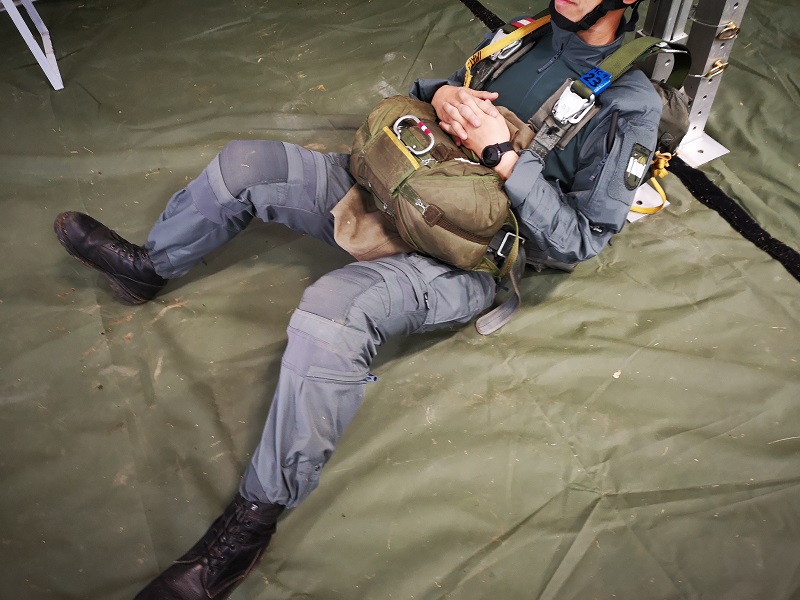 0600 – wo bleibt der Flieger? Wir tun das, was Soldaten am besten können, voll aufgerödelt warten. Nach zwei Stunden des Wartens kommt das Fluggerät endlich daher. Unten seht ihr die klassische Pilatus Porter PC-6.
0600 – wo bleibt der Flieger? Wir tun das, was Soldaten am besten können, voll aufgerödelt warten. Nach zwei Stunden des Wartens kommt das Fluggerät endlich daher. Unten seht ihr die klassische Pilatus Porter PC-6.
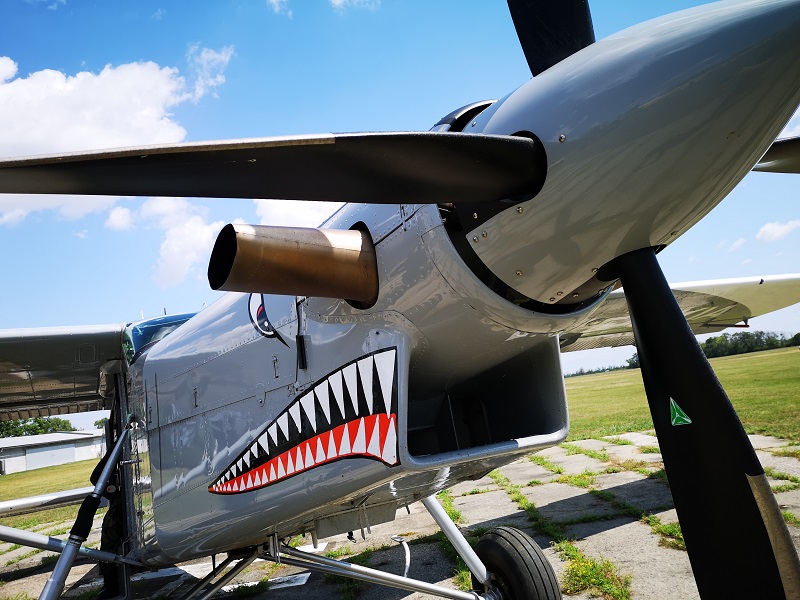 Dann überschlagen sich fast die Ereignisse. Nochmal alles checken, aufstellen und die ersten fünf Springer steigen in das Flugzeug. Wir sind in der dritten Sprunggruppe und können das ganze Spektakel beobachten. Keine zwei Minuten nach Start des Flugzeugs wird die Windrichtung mit einer abgeworfenen Papierrolle bestimmt.
Dann überschlagen sich fast die Ereignisse. Nochmal alles checken, aufstellen und die ersten fünf Springer steigen in das Flugzeug. Wir sind in der dritten Sprunggruppe und können das ganze Spektakel beobachten. Keine zwei Minuten nach Start des Flugzeugs wird die Windrichtung mit einer abgeworfenen Papierrolle bestimmt.
 Nach insgesamt fünf Minuten fällt der erste Springer kontrolliert aus dem Flugzeug. Der Schirm öffnet sich wie im Bilderbuch und er sinkt sicher zu Boden.
Nach insgesamt fünf Minuten fällt der erste Springer kontrolliert aus dem Flugzeug. Der Schirm öffnet sich wie im Bilderbuch und er sinkt sicher zu Boden.
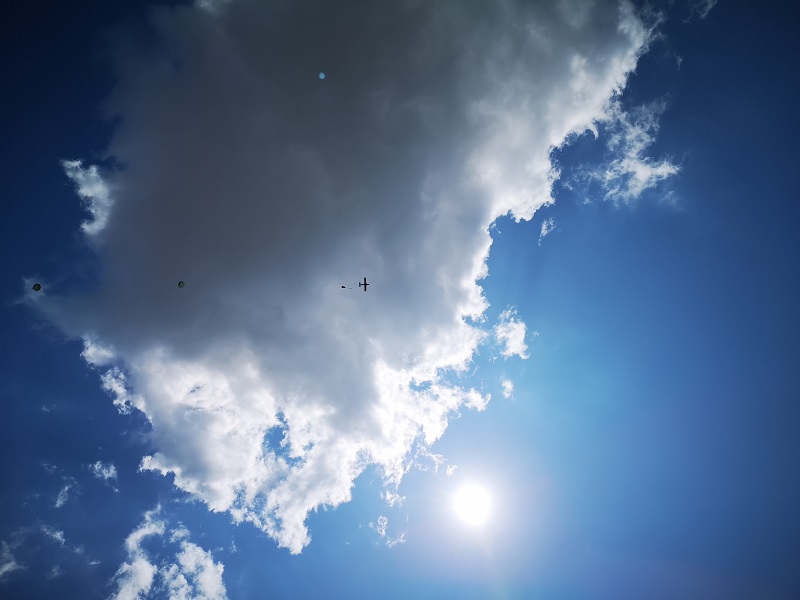 Kurz darauf folgen die weiteren Springer. Auch bei ihnen alles wie im Lehrbuch. Das sollte auch den ganzen Tag so bleiben. Niemand musste seinen Reserverschirm benutzen. Gutes Packen lohnt sich also …
Kurz darauf folgen die weiteren Springer. Auch bei ihnen alles wie im Lehrbuch. Das sollte auch den ganzen Tag so bleiben. Niemand musste seinen Reserverschirm benutzen. Gutes Packen lohnt sich also …
 Die ersten landen Wohlbehalten in der Landezone. Glück Ab.
Die ersten landen Wohlbehalten in der Landezone. Glück Ab.
 Nun sind wir an der Reihe. Der Körper ist irgendwie voller Adrenalin, die Gedanken kreisen im Kopf um Themen wie was, wann, wie getan werden muss. Das Flugzeug schraubt sich in die Höhe, die Tür wird vom Jumpmaster auf 600m geöffnet, der Pilot eingewiesen und dann tönt es auch schon „GO!“.
Nun sind wir an der Reihe. Der Körper ist irgendwie voller Adrenalin, die Gedanken kreisen im Kopf um Themen wie was, wann, wie getan werden muss. Das Flugzeug schraubt sich in die Höhe, die Tür wird vom Jumpmaster auf 600m geöffnet, der Pilot eingewiesen und dann tönt es auch schon „GO!“.
 Der erste verlässt den Bauch der Maschine und der zweite Sringer rückt umgehend auf seinen Platz nach. Das Schauspiel wiederholt sich bis alle fünf draußen sind.
Der erste verlässt den Bauch der Maschine und der zweite Sringer rückt umgehend auf seinen Platz nach. Das Schauspiel wiederholt sich bis alle fünf draußen sind.
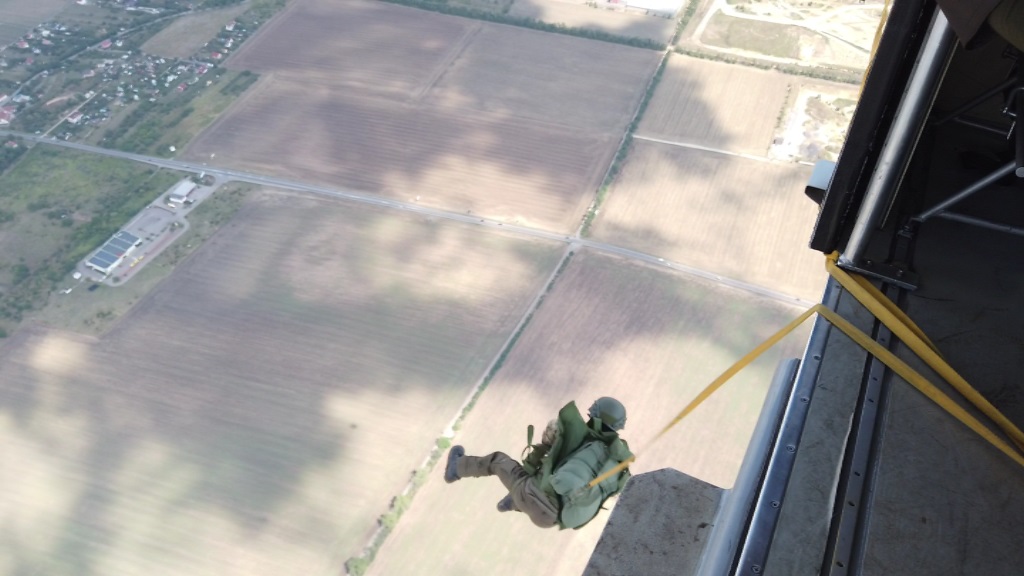 So auch wir. Die ersten Bruchteile des Sprung – oder doch eher Falls – bekommen wir nicht bewusst mit. Unser Körper hat sowas noch nie gemacht und kennt sich erstmal nicht aus, aber kurz darauf übernimmt das Gehirn wieder und wir beginnen laut zu zählen: 1.000, 2.000, 3.000, 4.000. Blick nach oben zur Kappe, sie ist offen und rund. Sieht sehr gut aus. Die Leinen sind noch etwas verdrillt, aber nach einem beherzten Ruck an den Gurten sind sie gelöst und wir hängen im Schirm – wie im Bilderbuch.
So auch wir. Die ersten Bruchteile des Sprung – oder doch eher Falls – bekommen wir nicht bewusst mit. Unser Körper hat sowas noch nie gemacht und kennt sich erstmal nicht aus, aber kurz darauf übernimmt das Gehirn wieder und wir beginnen laut zu zählen: 1.000, 2.000, 3.000, 4.000. Blick nach oben zur Kappe, sie ist offen und rund. Sieht sehr gut aus. Die Leinen sind noch etwas verdrillt, aber nach einem beherzten Ruck an den Gurten sind sie gelöst und wir hängen im Schirm – wie im Bilderbuch.
 Schnell nach den Kameraden umgesehen, auch bei ihnen ist alles gut. Noch schnell Step drei, der Blick nach unten. Wow, wie klein alles ist! Die Zeltstadt und die Flugpiste im Blick steuern wir den Schirm nach zu Boden.
Schnell nach den Kameraden umgesehen, auch bei ihnen ist alles gut. Noch schnell Step drei, der Blick nach unten. Wow, wie klein alles ist! Die Zeltstadt und die Flugpiste im Blick steuern wir den Schirm nach zu Boden.
Ein kurzer Blick in die Umgebung, Znaim im Morgenlicht wirkt malerisch. Auch das Kernkraftwerk Dukovany zeichnet sich mit seinen dampfenden Kühltürmen malerisch gen Horizont.
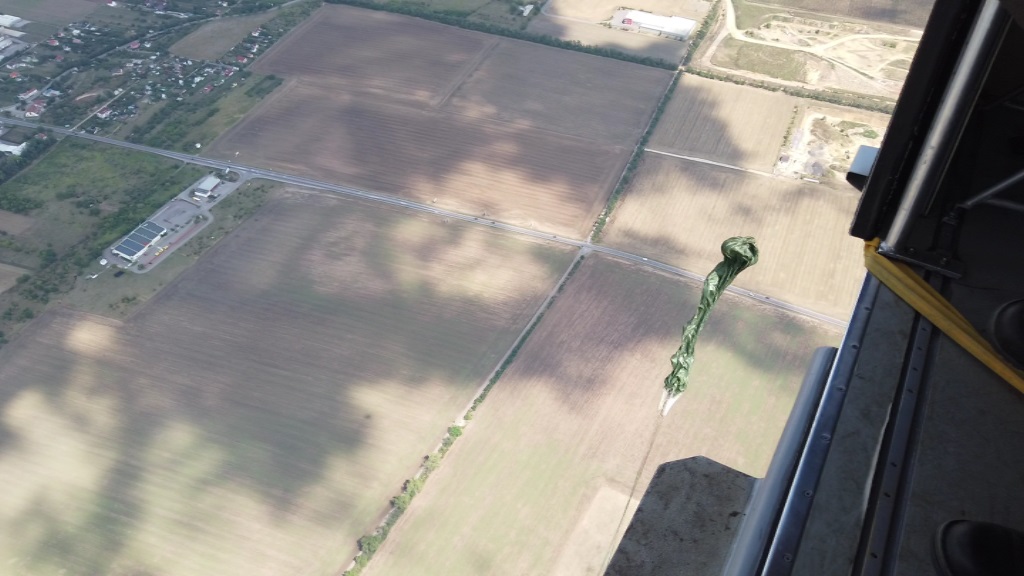 Nach einigen Lenkbewegungen ist der Boden nun sehr nahe. Schätzen können wir es nicht, aber es kann sich nur noch um Sekunden bis zum Aufschlag handeln, also Landehaltung einnehmen.
Nach einigen Lenkbewegungen ist der Boden nun sehr nahe. Schätzen können wir es nicht, aber es kann sich nur noch um Sekunden bis zum Aufschlag handeln, also Landehaltung einnehmen.
Füße zusammen, Knie leicht anwinkeln und gut an den Gurten festhalten. Es fühlt sich an wie eine Ewigkeit, aber dann berühren wir den Boden. Die Landerolle erfolgt komplett automatisiert.
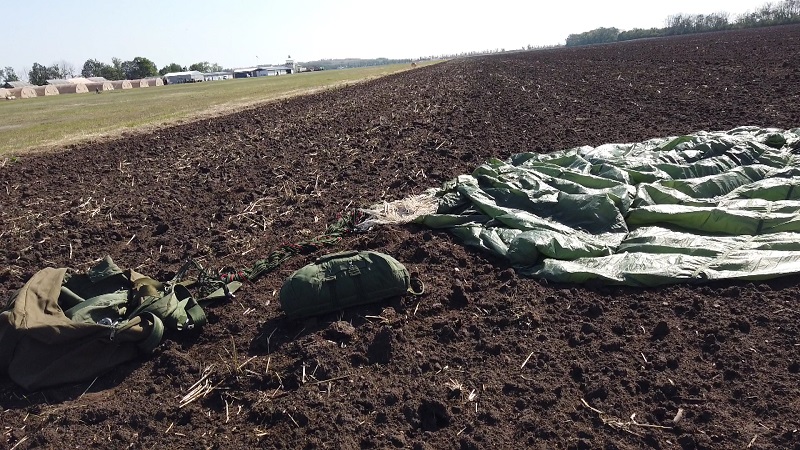 Wir sind zum Glück in einem sehr weichen Feld gelandet. Kurzer Selbstcheck, tut irgenendetwas seltsam weh? Nein, sehr gut. Sofort stehen wir auf und beginnen umgehend den Schirm, wie geübt, zusammenzulegen. Auch alle Kameraden sind wohlbehalten zu Mutter Erde zurückgekehrt.
Wir sind zum Glück in einem sehr weichen Feld gelandet. Kurzer Selbstcheck, tut irgenendetwas seltsam weh? Nein, sehr gut. Sofort stehen wir auf und beginnen umgehend den Schirm, wie geübt, zusammenzulegen. Auch alle Kameraden sind wohlbehalten zu Mutter Erde zurückgekehrt.
Mit dem fertig verpackten Schirm machen wir uns auf den Fußweg zurück zur Basis. Wir fassen sofort einen neuen Schirm aus und das himmlische Schauspiel wiederholt sich.
Insgesamt springen wir an diesem schönen Tag dreimal. Am Ende hat nur ein Springer bei der Landung etwas Pech gehabt und sich den Fuß leicht gestaucht. Alle anderen konnten den Kurs verletzungsfrei abschließen.
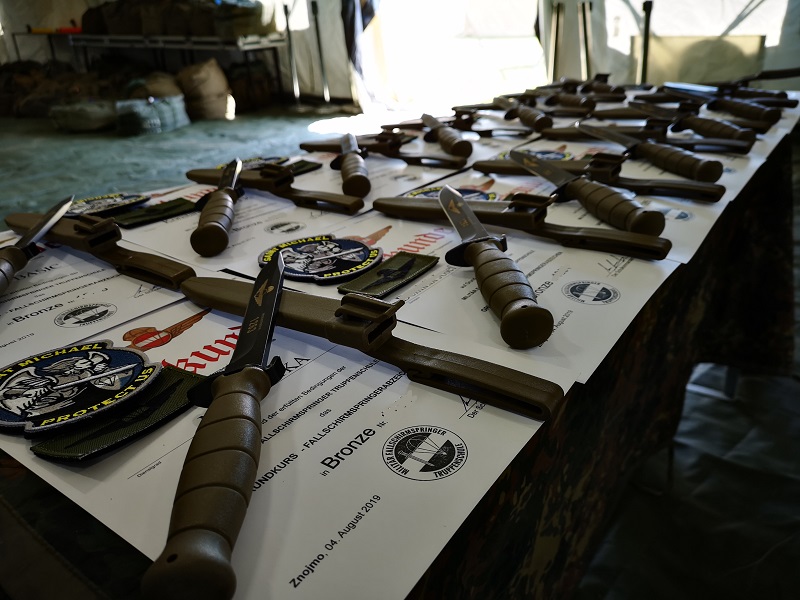 Am frühen Nachmittag wurde jedem noch seine MFTS Urkunde überreicht und dann hieß es auch schon wieder zusammenpacken und rückverlegen nach Wien. Hier nochmal der Link zum Video auf Youtube.
Am frühen Nachmittag wurde jedem noch seine MFTS Urkunde überreicht und dann hieß es auch schon wieder zusammenpacken und rückverlegen nach Wien. Hier nochmal der Link zum Video auf Youtube.
FAZIT: Wer militärisches Fallschirmspringen mit der Static Line lernen will, ist hier definitiv am richtigen Ort. Die Ausbilder sind fähig und vermitteln ihr Wissen sehr gut. Die Sprungausrüstung ist im tadellosen Zustand und befördert einen sicher nach unten. Das Essen ist obendrein vorzüglich, ganz nach dem Motto: „Ohne Mampf kein Kampf“. Bei der MFTS wird auf Sicherheit und Gesundheit aller Teilnehmer größter Wert gelegt und man fühlt sich auch gut aufgehoben. Das ist gut so: Wer springt sonst schon freiwillig aus einem Flugzeug. Wer nach dem ersten Mal probieren aus den Geschmack gekommen ist: die Truppenschule bietet das volle Programm.
Die MFTS im Internet: mfts.army
SPARTANAT ist das Online-Magazin für Military News, Tactical Life, Gear & Reviews.
Schickt uns eure News: [email protected]
Werbung
Hol Dir den wöchentlichen SPARTANAT-Newsletter.
Dein Bonus: das gratis E-Book von SPARTANAT.


